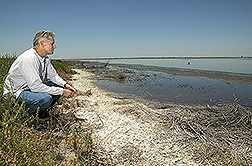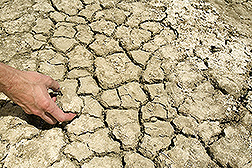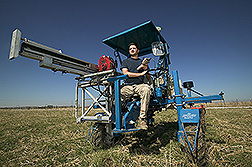Salvaging Saline Water and Soils
|
|
Nestled in the hills of California’s San Joaquin Valley, a tranquil pond invites flocks of ruddy ducks, pintails, and shovelers to feed at its shores. The water’s crawling with the larvae of brine flies and midges these waterfowl love.
But this pond doesn’t constitute the ideal refuge. White, encrusted salts can be seen at its edges, evidence that its waters are as saline as the ocean. The body of water—known as an evaporation pond—is actually a human-built basin made for trapping drainage waters that have no other place to go in the tightly managed agricultural valley.
With an annual rainfall of about 5 inches, this part of California’s Central Valley requires extensive irrigation to produce the abundant fruits, vegetables, and nuts it supplies to the nation’s supermarkets year-round.
But when routinely applied to fields, imported waters and the salts they carry can build up in the soil, threatening to impair fledgling crops and decrease crop yields. To make matters worse, a pervasive layer of clay in the region’s soils acts as a barrier, keeping water from trickling further down into the ground.
To meet these geologic challenges and reach their irrigation goals, area growers have installed subsurface tile lines and drains to carry drainage water to evaporation ponds. But the ponds can create some problems of their own.
Troubled Waters
Dennis Corwin, an ARS soil scientist, is familiar with the difficulties associated with evaporation ponds. He works at the agency’s George E. Brown, Jr., Salinity Laboratory in Riverside, California, specializing in assessment and monitoring of saline soils.
“These ponds are a considerable liability to farmers because they take land out of production and are time consuming to manage,” says Corwin. “Generally speaking—on the west side of the San Joaquin Valley—for every 9 acres of land in production, 1 acre is needed for evaporation ponds.”
In addition to their high salinity, some ponds may contain above-normal amounts of selenium, boron, and arsenic, which can be toxic to plants, wildlife, and the many bird populations that migrate through or overwinter in the area. Selenium shows up in the valley’s soils and waters because nearby mountain ranges are composed of marine sedimentary rocks enriched with the element.
As part of a team of scientists, Corwin is working with Westlake Farms, in western San Joaquin Valley, to help owner Ceil Howe III lessen the need for evaporation ponds by reducing the volume of drainage water. Corwin and collaborators at the University of California (UC) at Davis and UC-Riverside have demonstrated a way to shrink the ponds—and grow a profitable crop at the same time.
Their approach? Plant a high-quality, salt-tolerant forage crop, such as bermudagrass, on nonproductive, saline soils, and then irrigate it with the drainage water. With careful management, the grass crop will flourish and provide affordable forage for livestock.
The project—with a team of soil, crop, and animal scientists, plus a resource economist—is in its sixth year. One of its major benefits has been that the grower has gotten to cultivate land that would probably never have been used.
“Cattle can graze on the bermudagrass,” Corwin explains. “With eight paddocks, we can rotate the animals so they’re kept off the fields being irrigated.” An animal scientist is monitoring the animals’ health, since some elements—especially molybdenum—can cause digestion problems in ruminants.
The researchers have met their goals of significantly reducing drainage-water volume and the need for evaporation ponds and bringing nonproductive soils back into use. “We’ve shown a way that drainage water can be reused even in the most difficult soil conditions in California,” Corwin says.
The Road to Reclamation
Initially, the soil being planted with the test forage crop was very poor, with high salinity, sodium, and molybdenum levels. The irrigation water from the evaporation ponds was about half as high in those elements as the soil. According to Corwin, when managed properly, these poor soil and water conditions can be overcome.
“When you apply good-quality water (with low salinity and sodium levels) to saline-sodic soil, the water just ponds on the surface,” explains Corwin. “With these conditions, you need irrigation water that is high enough in salinity to enhance infiltration, but low enough to leach high levels of salt in the soil.
“The soil at the Westlake site is high in clays that expand when wet,” Corwin continues. “Once the soil is wet, it can be difficult to get more water into it to remove salts. To remedy this, the farmers let the soil dry out so it forms cracks that the water can run through. The key is adding enough water to fill the cracks and leach the salts without overirrigating and sealing the soil.”
Innovation and Willingness
The soil is improving at the test site and so is the appearance of the forage crop. “It’s looking better each year,” says Corwin. “At first the site was patchy and had weeds. It looked so bad that you couldn’t even tell we were running an experiment. Now, the bermudagrass is expanding and filling in areas that were previously bare.”
But the big question is the practice’s sustainability over the long term. What will the soil quality be 10, 20, and 30 years from now? While almost 6 years of data are significant, the researchers hope to continue monitoring the site.
According to Corwin, much of the project’s success has rested on the Howe family’s receptiveness to the ideas being developed by ARS and UC scientists.
“The science and technology to manage difficult, saline-sodic soils have been available for decades,” says Corwin. “But the combined efforts between researchers and the farmer were key to the current level of success. We’ve been able to draw on the scientific knowledge and practical expertise of both groups.”
The Howe family has already expanded the acreage using this approach, since they’ve been so impressed with it. “The project has been an immense success,” says Howe. “We’ve produced high-quality forage using drainage water blended with some of our other water sources. And the amount of water stored in the ponds has been reduced. I believe projects such as this, on a larger scale, will allow farmers to install drainage without building additional evaporation ponds.”—By Erin K. Peabody, Agricultural Research Service Information Staff.
This research is part of Soil Resource Management, an ARS National Program (#202) described on the World Wide Web at http://www.ars.usda.gov/research/programs.htm.
Dennis L. Corwin is with the USDA-ARS George E. Brown, Jr., Salinity Laboratory, 450 W. Big Springs Rd., Riverside, CA 92507-4617; phone (909) 369-4819, fax (909) 342-4962.
"Salvaging Saline Water and Soils" was published in the September 2005 issue of Agricultural Research magazine.









